Nursing Care for Type 2 Diabetes: Management through Diet and Education
VerifiedAdded on 2022/11/22
|12
|3611
|174
AI Summary
This report discusses the issues faced by patients with type 2 diabetes and highlights the various ways to handle the condition. It compares diet plans for Australian natives to reduce insulin resistance. The report also identifies research articles related to type 2 diabetes management among nurses.
Contribute Materials
Your contribution can guide someone’s learning journey. Share your
documents today.
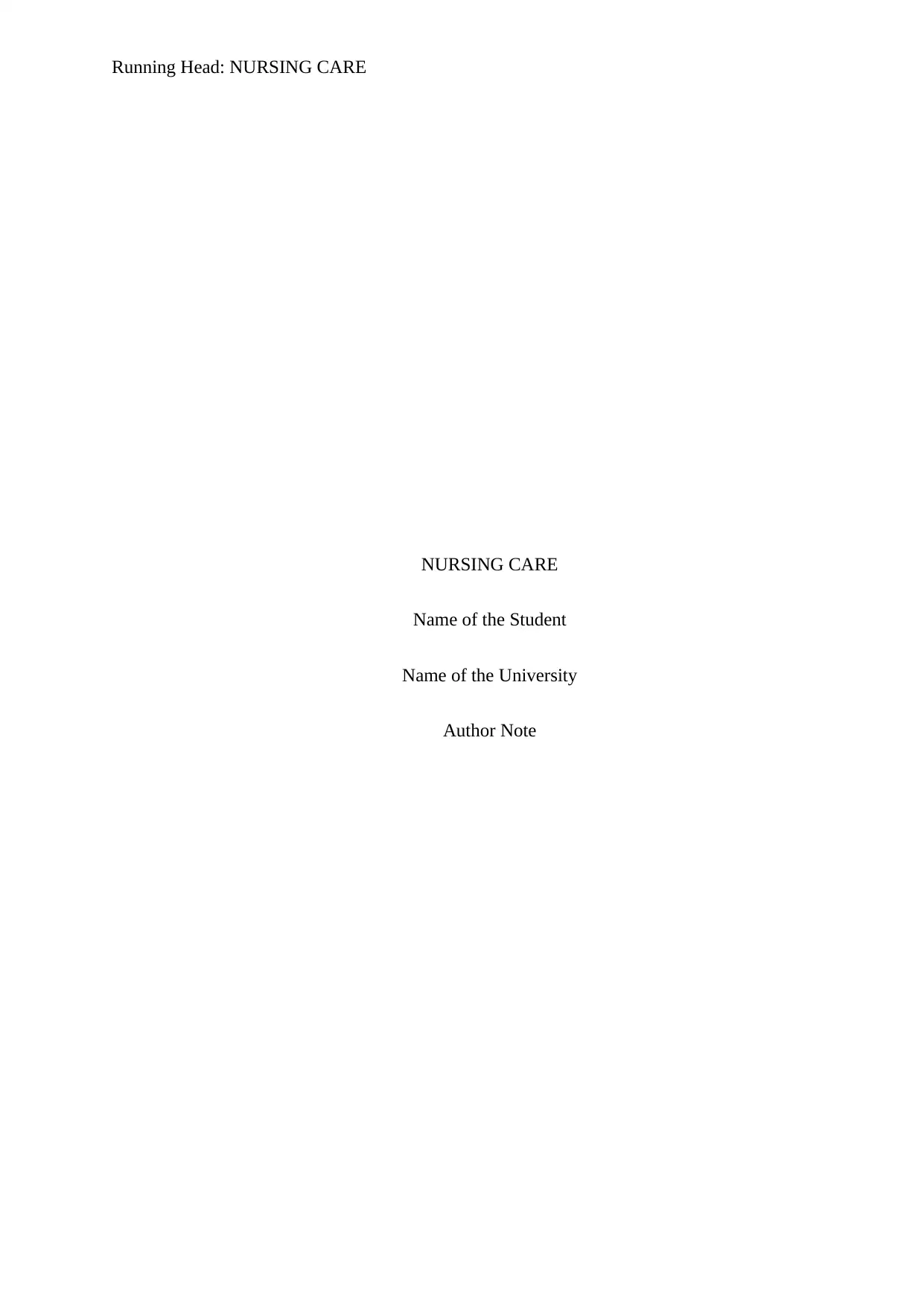
Running Head: NURSING CARE
NURSING CARE
Name of the Student
Name of the University
Author Note
NURSING CARE
Name of the Student
Name of the University
Author Note
Secure Best Marks with AI Grader
Need help grading? Try our AI Grader for instant feedback on your assignments.
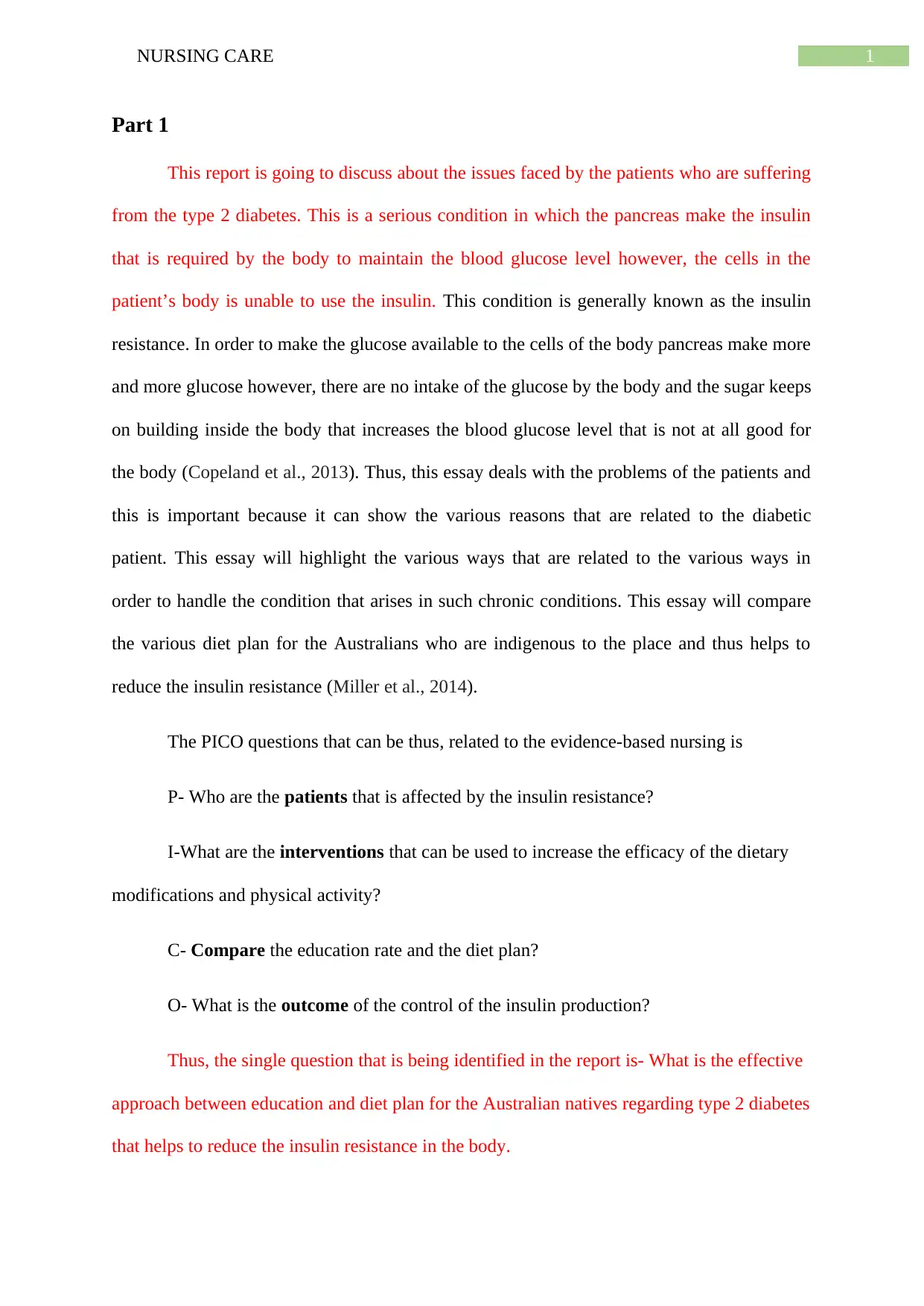
1NURSING CARE
Part 1
This report is going to discuss about the issues faced by the patients who are suffering
from the type 2 diabetes. This is a serious condition in which the pancreas make the insulin
that is required by the body to maintain the blood glucose level however, the cells in the
patient’s body is unable to use the insulin. This condition is generally known as the insulin
resistance. In order to make the glucose available to the cells of the body pancreas make more
and more glucose however, there are no intake of the glucose by the body and the sugar keeps
on building inside the body that increases the blood glucose level that is not at all good for
the body (Copeland et al., 2013). Thus, this essay deals with the problems of the patients and
this is important because it can show the various reasons that are related to the diabetic
patient. This essay will highlight the various ways that are related to the various ways in
order to handle the condition that arises in such chronic conditions. This essay will compare
the various diet plan for the Australians who are indigenous to the place and thus helps to
reduce the insulin resistance (Miller et al., 2014).
The PICO questions that can be thus, related to the evidence-based nursing is
P- Who are the patients that is affected by the insulin resistance?
I-What are the interventions that can be used to increase the efficacy of the dietary
modifications and physical activity?
C- Compare the education rate and the diet plan?
O- What is the outcome of the control of the insulin production?
Thus, the single question that is being identified in the report is- What is the effective
approach between education and diet plan for the Australian natives regarding type 2 diabetes
that helps to reduce the insulin resistance in the body.
Part 1
This report is going to discuss about the issues faced by the patients who are suffering
from the type 2 diabetes. This is a serious condition in which the pancreas make the insulin
that is required by the body to maintain the blood glucose level however, the cells in the
patient’s body is unable to use the insulin. This condition is generally known as the insulin
resistance. In order to make the glucose available to the cells of the body pancreas make more
and more glucose however, there are no intake of the glucose by the body and the sugar keeps
on building inside the body that increases the blood glucose level that is not at all good for
the body (Copeland et al., 2013). Thus, this essay deals with the problems of the patients and
this is important because it can show the various reasons that are related to the diabetic
patient. This essay will highlight the various ways that are related to the various ways in
order to handle the condition that arises in such chronic conditions. This essay will compare
the various diet plan for the Australians who are indigenous to the place and thus helps to
reduce the insulin resistance (Miller et al., 2014).
The PICO questions that can be thus, related to the evidence-based nursing is
P- Who are the patients that is affected by the insulin resistance?
I-What are the interventions that can be used to increase the efficacy of the dietary
modifications and physical activity?
C- Compare the education rate and the diet plan?
O- What is the outcome of the control of the insulin production?
Thus, the single question that is being identified in the report is- What is the effective
approach between education and diet plan for the Australian natives regarding type 2 diabetes
that helps to reduce the insulin resistance in the body.
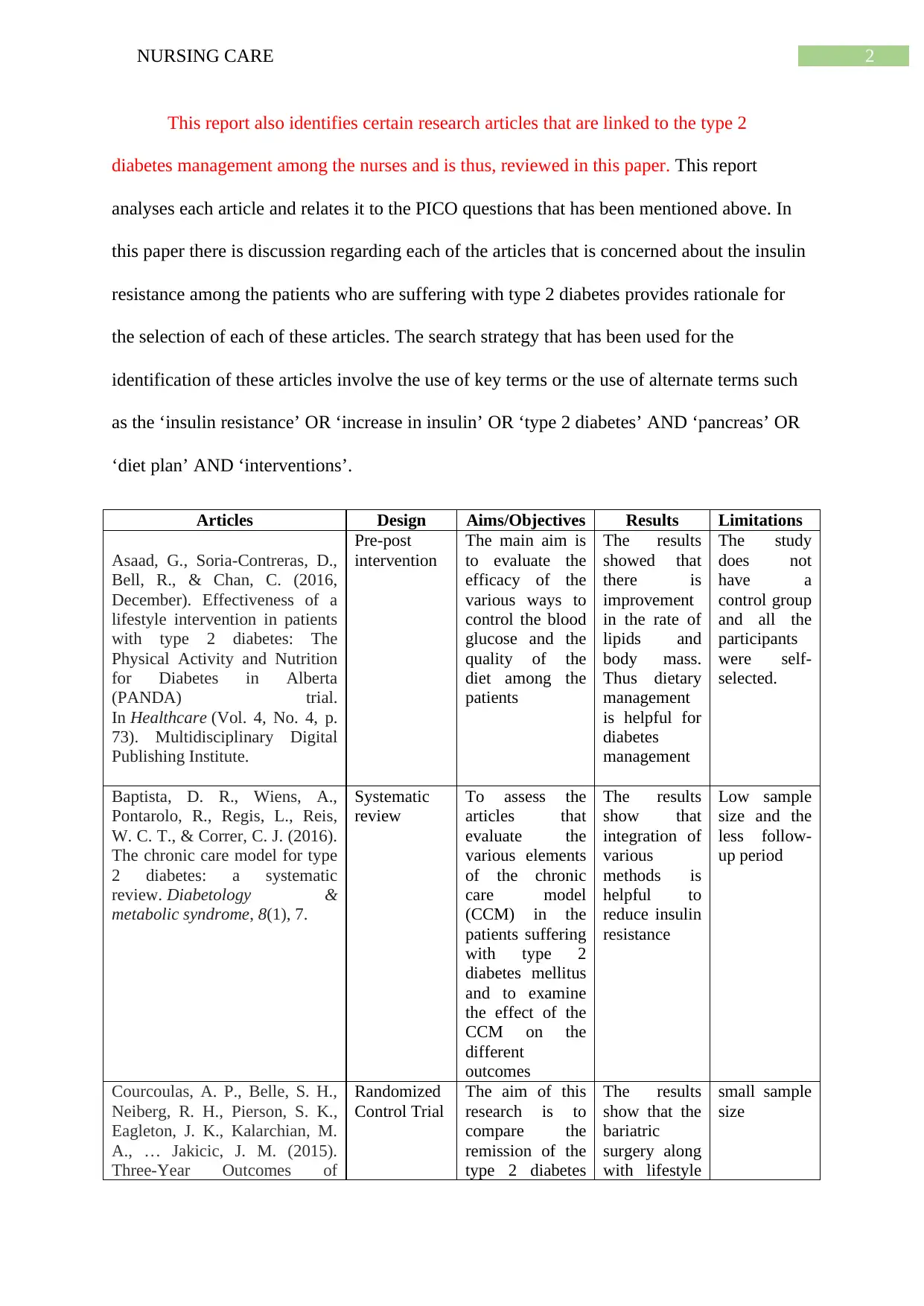
2NURSING CARE
This report also identifies certain research articles that are linked to the type 2
diabetes management among the nurses and is thus, reviewed in this paper. This report
analyses each article and relates it to the PICO questions that has been mentioned above. In
this paper there is discussion regarding each of the articles that is concerned about the insulin
resistance among the patients who are suffering with type 2 diabetes provides rationale for
the selection of each of these articles. The search strategy that has been used for the
identification of these articles involve the use of key terms or the use of alternate terms such
as the ‘insulin resistance’ OR ‘increase in insulin’ OR ‘type 2 diabetes’ AND ‘pancreas’ OR
‘diet plan’ AND ‘interventions’.
Articles Design Aims/Objectives Results Limitations
Asaad, G., Soria-Contreras, D.,
Bell, R., & Chan, C. (2016,
December). Effectiveness of a
lifestyle intervention in patients
with type 2 diabetes: The
Physical Activity and Nutrition
for Diabetes in Alberta
(PANDA) trial.
In Healthcare (Vol. 4, No. 4, p.
73). Multidisciplinary Digital
Publishing Institute.
Pre-post
intervention
The main aim is
to evaluate the
efficacy of the
various ways to
control the blood
glucose and the
quality of the
diet among the
patients
The results
showed that
there is
improvement
in the rate of
lipids and
body mass.
Thus dietary
management
is helpful for
diabetes
management
The study
does not
have a
control group
and all the
participants
were self-
selected.
Baptista, D. R., Wiens, A.,
Pontarolo, R., Regis, L., Reis,
W. C. T., & Correr, C. J. (2016).
The chronic care model for type
2 diabetes: a systematic
review. Diabetology &
metabolic syndrome, 8(1), 7.
Systematic
review
To assess the
articles that
evaluate the
various elements
of the chronic
care model
(CCM) in the
patients suffering
with type 2
diabetes mellitus
and to examine
the effect of the
CCM on the
different
outcomes
The results
show that
integration of
various
methods is
helpful to
reduce insulin
resistance
Low sample
size and the
less follow-
up period
Courcoulas, A. P., Belle, S. H.,
Neiberg, R. H., Pierson, S. K.,
Eagleton, J. K., Kalarchian, M.
A., … Jakicic, J. M. (2015).
Three-Year Outcomes of
Randomized
Control Trial
The aim of this
research is to
compare the
remission of the
type 2 diabetes
The results
show that the
bariatric
surgery along
with lifestyle
small sample
size
This report also identifies certain research articles that are linked to the type 2
diabetes management among the nurses and is thus, reviewed in this paper. This report
analyses each article and relates it to the PICO questions that has been mentioned above. In
this paper there is discussion regarding each of the articles that is concerned about the insulin
resistance among the patients who are suffering with type 2 diabetes provides rationale for
the selection of each of these articles. The search strategy that has been used for the
identification of these articles involve the use of key terms or the use of alternate terms such
as the ‘insulin resistance’ OR ‘increase in insulin’ OR ‘type 2 diabetes’ AND ‘pancreas’ OR
‘diet plan’ AND ‘interventions’.
Articles Design Aims/Objectives Results Limitations
Asaad, G., Soria-Contreras, D.,
Bell, R., & Chan, C. (2016,
December). Effectiveness of a
lifestyle intervention in patients
with type 2 diabetes: The
Physical Activity and Nutrition
for Diabetes in Alberta
(PANDA) trial.
In Healthcare (Vol. 4, No. 4, p.
73). Multidisciplinary Digital
Publishing Institute.
Pre-post
intervention
The main aim is
to evaluate the
efficacy of the
various ways to
control the blood
glucose and the
quality of the
diet among the
patients
The results
showed that
there is
improvement
in the rate of
lipids and
body mass.
Thus dietary
management
is helpful for
diabetes
management
The study
does not
have a
control group
and all the
participants
were self-
selected.
Baptista, D. R., Wiens, A.,
Pontarolo, R., Regis, L., Reis,
W. C. T., & Correr, C. J. (2016).
The chronic care model for type
2 diabetes: a systematic
review. Diabetology &
metabolic syndrome, 8(1), 7.
Systematic
review
To assess the
articles that
evaluate the
various elements
of the chronic
care model
(CCM) in the
patients suffering
with type 2
diabetes mellitus
and to examine
the effect of the
CCM on the
different
outcomes
The results
show that
integration of
various
methods is
helpful to
reduce insulin
resistance
Low sample
size and the
less follow-
up period
Courcoulas, A. P., Belle, S. H.,
Neiberg, R. H., Pierson, S. K.,
Eagleton, J. K., Kalarchian, M.
A., … Jakicic, J. M. (2015).
Three-Year Outcomes of
Randomized
Control Trial
The aim of this
research is to
compare the
remission of the
type 2 diabetes
The results
show that the
bariatric
surgery along
with lifestyle
small sample
size
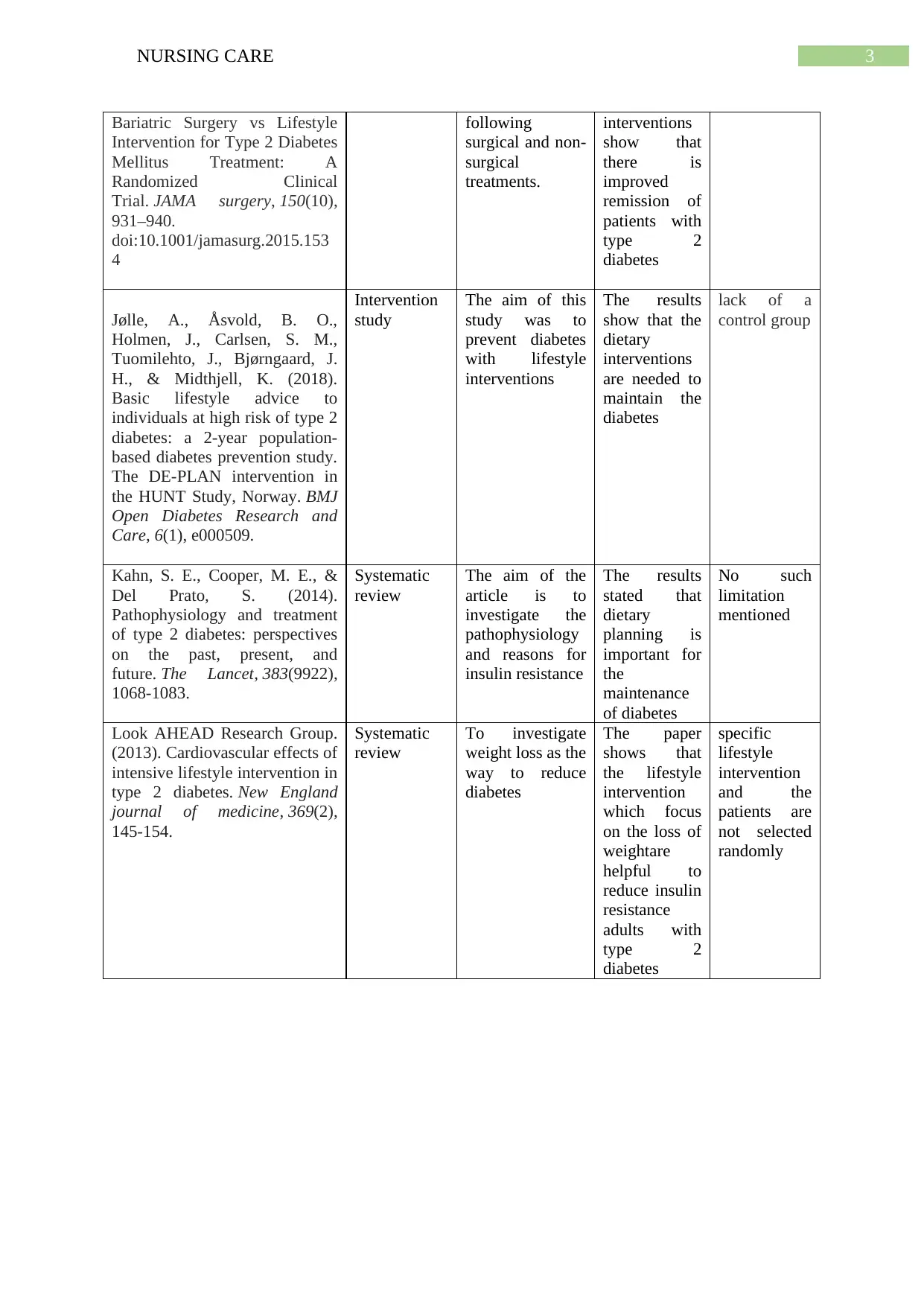
3NURSING CARE
Bariatric Surgery vs Lifestyle
Intervention for Type 2 Diabetes
Mellitus Treatment: A
Randomized Clinical
Trial. JAMA surgery, 150(10),
931–940.
doi:10.1001/jamasurg.2015.153
4
following
surgical and non-
surgical
treatments.
interventions
show that
there is
improved
remission of
patients with
type 2
diabetes
Jølle, A., Åsvold, B. O.,
Holmen, J., Carlsen, S. M.,
Tuomilehto, J., Bjørngaard, J.
H., & Midthjell, K. (2018).
Basic lifestyle advice to
individuals at high risk of type 2
diabetes: a 2-year population-
based diabetes prevention study.
The DE-PLAN intervention in
the HUNT Study, Norway. BMJ
Open Diabetes Research and
Care, 6(1), e000509.
Intervention
study
The aim of this
study was to
prevent diabetes
with lifestyle
interventions
The results
show that the
dietary
interventions
are needed to
maintain the
diabetes
lack of a
control group
Kahn, S. E., Cooper, M. E., &
Del Prato, S. (2014).
Pathophysiology and treatment
of type 2 diabetes: perspectives
on the past, present, and
future. The Lancet, 383(9922),
1068-1083.
Systematic
review
The aim of the
article is to
investigate the
pathophysiology
and reasons for
insulin resistance
The results
stated that
dietary
planning is
important for
the
maintenance
of diabetes
No such
limitation
mentioned
Look AHEAD Research Group.
(2013). Cardiovascular effects of
intensive lifestyle intervention in
type 2 diabetes. New England
journal of medicine, 369(2),
145-154.
Systematic
review
To investigate
weight loss as the
way to reduce
diabetes
The paper
shows that
the lifestyle
intervention
which focus
on the loss of
weightare
helpful to
reduce insulin
resistance
adults with
type 2
diabetes
specific
lifestyle
intervention
and the
patients are
not selected
randomly
Bariatric Surgery vs Lifestyle
Intervention for Type 2 Diabetes
Mellitus Treatment: A
Randomized Clinical
Trial. JAMA surgery, 150(10),
931–940.
doi:10.1001/jamasurg.2015.153
4
following
surgical and non-
surgical
treatments.
interventions
show that
there is
improved
remission of
patients with
type 2
diabetes
Jølle, A., Åsvold, B. O.,
Holmen, J., Carlsen, S. M.,
Tuomilehto, J., Bjørngaard, J.
H., & Midthjell, K. (2018).
Basic lifestyle advice to
individuals at high risk of type 2
diabetes: a 2-year population-
based diabetes prevention study.
The DE-PLAN intervention in
the HUNT Study, Norway. BMJ
Open Diabetes Research and
Care, 6(1), e000509.
Intervention
study
The aim of this
study was to
prevent diabetes
with lifestyle
interventions
The results
show that the
dietary
interventions
are needed to
maintain the
diabetes
lack of a
control group
Kahn, S. E., Cooper, M. E., &
Del Prato, S. (2014).
Pathophysiology and treatment
of type 2 diabetes: perspectives
on the past, present, and
future. The Lancet, 383(9922),
1068-1083.
Systematic
review
The aim of the
article is to
investigate the
pathophysiology
and reasons for
insulin resistance
The results
stated that
dietary
planning is
important for
the
maintenance
of diabetes
No such
limitation
mentioned
Look AHEAD Research Group.
(2013). Cardiovascular effects of
intensive lifestyle intervention in
type 2 diabetes. New England
journal of medicine, 369(2),
145-154.
Systematic
review
To investigate
weight loss as the
way to reduce
diabetes
The paper
shows that
the lifestyle
intervention
which focus
on the loss of
weightare
helpful to
reduce insulin
resistance
adults with
type 2
diabetes
specific
lifestyle
intervention
and the
patients are
not selected
randomly
Secure Best Marks with AI Grader
Need help grading? Try our AI Grader for instant feedback on your assignments.

4NURSING CARE
Part 2
As it has already been summarized in the first part regarding the evidences of each
paper that has been selected. The evidences show that all the papers are either RCT or pre-
post intervention study or systemic review and hence complies all the facts that has already
been stated in the pre-existing articles (Espeland et al., 2014). All the articles that are selected
are all related to the PICO question that has been mentioned above. The chosen articles
highlight that the management of the type 2 diabetes management that are prevalent in the
hospitals while they deliver care and medicines to the patients (Schellenberg et al., 2014).
Articles P-
Population
I-
Interventions
C-
Comparison
O-Outcome
Asaad, G., Soria-Contreras, D.,
Bell, R., & Chan, C. (2016,
December). Effectiveness of a
lifestyle intervention in patients
with type 2 diabetes: The
Physical Activity and Nutrition
for Diabetes in Alberta
(PANDA) trial.
In Healthcare (Vol. 4, No. 4, p.
73). Multidisciplinary Digital
Publishing Institute.
73
participants
out of which
39 men and
34 women
The behavioral
model is used
to know the
change in the
diet of the
participants
called PANDA
intervention
The
comparison of
the methods
for the dietary
interventions
The results
show the
application of
the
intervention
showed that
there is
decrease in the
A1c levels and
the
improvement
in the BMI,
blood pressure
or fat content
Baptista, D. R., Wiens, A.,
Pontarolo, R., Regis, L., Reis,
W. C. T., & Correr, C. J. (2016).
The chronic care model for type
2 diabetes: a systematic
review. Diabetology &
metabolic syndrome, 8(1), 7.
273
publications
were
selected for
systematic
review
The articles
were scanned
and out of that
26 articles
were used
The methods
mentioned in
the articles
were usedfor
the analysis of
the various
ways to know
the control
type 2 diabetes
The results
show that
articles were
used focused
on the care
model to
reduce the
insulin
resistance
Courcoulas, A. P., Belle, S. H.,
Neiberg, R. H., Pierson, S. K.,
Eagleton, J. K., Kalarchian, M.
A., … Jakicic, J. M. (2015).
Three-Year Outcomes of
Bariatric Surgery vs Lifestyle
Intervention for Type 2 Diabetes
Mellitus Treatment: A
Randomized Clinical
Trial. JAMA surgery, 150(10),
931–940.
61
participants
were
selected
A surgery was
linked with
greater weight
loss and
glycemic
control
It compared
the method of
Longitudinal
Assessment of
Bariatric
Surgery
(LABS) Study
The results
showed the
greater efficacy
of the applied
intervention
Part 2
As it has already been summarized in the first part regarding the evidences of each
paper that has been selected. The evidences show that all the papers are either RCT or pre-
post intervention study or systemic review and hence complies all the facts that has already
been stated in the pre-existing articles (Espeland et al., 2014). All the articles that are selected
are all related to the PICO question that has been mentioned above. The chosen articles
highlight that the management of the type 2 diabetes management that are prevalent in the
hospitals while they deliver care and medicines to the patients (Schellenberg et al., 2014).
Articles P-
Population
I-
Interventions
C-
Comparison
O-Outcome
Asaad, G., Soria-Contreras, D.,
Bell, R., & Chan, C. (2016,
December). Effectiveness of a
lifestyle intervention in patients
with type 2 diabetes: The
Physical Activity and Nutrition
for Diabetes in Alberta
(PANDA) trial.
In Healthcare (Vol. 4, No. 4, p.
73). Multidisciplinary Digital
Publishing Institute.
73
participants
out of which
39 men and
34 women
The behavioral
model is used
to know the
change in the
diet of the
participants
called PANDA
intervention
The
comparison of
the methods
for the dietary
interventions
The results
show the
application of
the
intervention
showed that
there is
decrease in the
A1c levels and
the
improvement
in the BMI,
blood pressure
or fat content
Baptista, D. R., Wiens, A.,
Pontarolo, R., Regis, L., Reis,
W. C. T., & Correr, C. J. (2016).
The chronic care model for type
2 diabetes: a systematic
review. Diabetology &
metabolic syndrome, 8(1), 7.
273
publications
were
selected for
systematic
review
The articles
were scanned
and out of that
26 articles
were used
The methods
mentioned in
the articles
were usedfor
the analysis of
the various
ways to know
the control
type 2 diabetes
The results
show that
articles were
used focused
on the care
model to
reduce the
insulin
resistance
Courcoulas, A. P., Belle, S. H.,
Neiberg, R. H., Pierson, S. K.,
Eagleton, J. K., Kalarchian, M.
A., … Jakicic, J. M. (2015).
Three-Year Outcomes of
Bariatric Surgery vs Lifestyle
Intervention for Type 2 Diabetes
Mellitus Treatment: A
Randomized Clinical
Trial. JAMA surgery, 150(10),
931–940.
61
participants
were
selected
A surgery was
linked with
greater weight
loss and
glycemic
control
It compared
the method of
Longitudinal
Assessment of
Bariatric
Surgery
(LABS) Study
The results
showed the
greater efficacy
of the applied
intervention
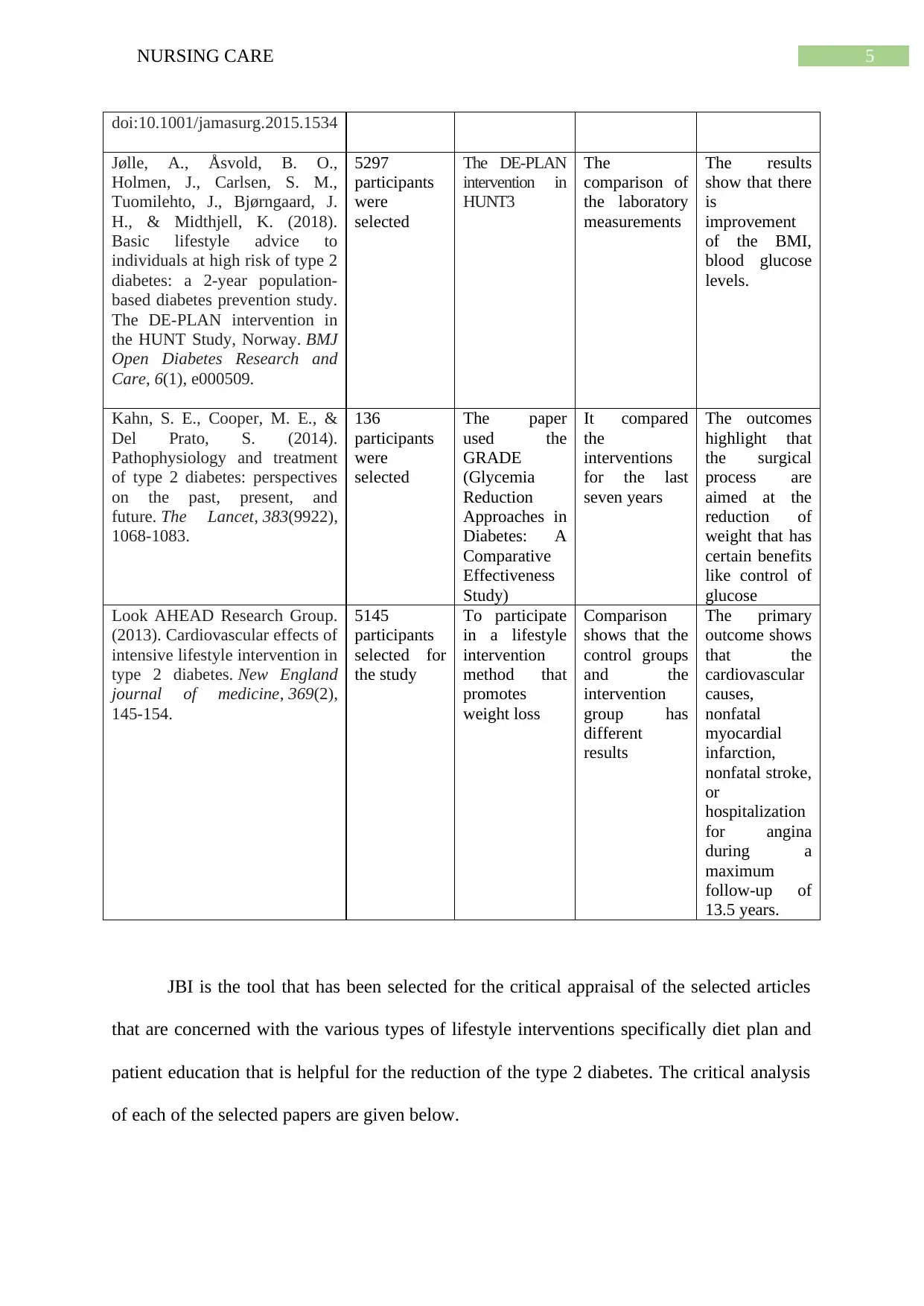
5NURSING CARE
doi:10.1001/jamasurg.2015.1534
Jølle, A., Åsvold, B. O.,
Holmen, J., Carlsen, S. M.,
Tuomilehto, J., Bjørngaard, J.
H., & Midthjell, K. (2018).
Basic lifestyle advice to
individuals at high risk of type 2
diabetes: a 2-year population-
based diabetes prevention study.
The DE-PLAN intervention in
the HUNT Study, Norway. BMJ
Open Diabetes Research and
Care, 6(1), e000509.
5297
participants
were
selected
The DE-PLAN
intervention in
HUNT3
The
comparison of
the laboratory
measurements
The results
show that there
is
improvement
of the BMI,
blood glucose
levels.
Kahn, S. E., Cooper, M. E., &
Del Prato, S. (2014).
Pathophysiology and treatment
of type 2 diabetes: perspectives
on the past, present, and
future. The Lancet, 383(9922),
1068-1083.
136
participants
were
selected
The paper
used the
GRADE
(Glycemia
Reduction
Approaches in
Diabetes: A
Comparative
Effectiveness
Study)
It compared
the
interventions
for the last
seven years
The outcomes
highlight that
the surgical
process are
aimed at the
reduction of
weight that has
certain benefits
like control of
glucose
Look AHEAD Research Group.
(2013). Cardiovascular effects of
intensive lifestyle intervention in
type 2 diabetes. New England
journal of medicine, 369(2),
145-154.
5145
participants
selected for
the study
To participate
in a lifestyle
intervention
method that
promotes
weight loss
Comparison
shows that the
control groups
and the
intervention
group has
different
results
The primary
outcome shows
that the
cardiovascular
causes,
nonfatal
myocardial
infarction,
nonfatal stroke,
or
hospitalization
for angina
during a
maximum
follow-up of
13.5 years.
JBI is the tool that has been selected for the critical appraisal of the selected articles
that are concerned with the various types of lifestyle interventions specifically diet plan and
patient education that is helpful for the reduction of the type 2 diabetes. The critical analysis
of each of the selected papers are given below.
doi:10.1001/jamasurg.2015.1534
Jølle, A., Åsvold, B. O.,
Holmen, J., Carlsen, S. M.,
Tuomilehto, J., Bjørngaard, J.
H., & Midthjell, K. (2018).
Basic lifestyle advice to
individuals at high risk of type 2
diabetes: a 2-year population-
based diabetes prevention study.
The DE-PLAN intervention in
the HUNT Study, Norway. BMJ
Open Diabetes Research and
Care, 6(1), e000509.
5297
participants
were
selected
The DE-PLAN
intervention in
HUNT3
The
comparison of
the laboratory
measurements
The results
show that there
is
improvement
of the BMI,
blood glucose
levels.
Kahn, S. E., Cooper, M. E., &
Del Prato, S. (2014).
Pathophysiology and treatment
of type 2 diabetes: perspectives
on the past, present, and
future. The Lancet, 383(9922),
1068-1083.
136
participants
were
selected
The paper
used the
GRADE
(Glycemia
Reduction
Approaches in
Diabetes: A
Comparative
Effectiveness
Study)
It compared
the
interventions
for the last
seven years
The outcomes
highlight that
the surgical
process are
aimed at the
reduction of
weight that has
certain benefits
like control of
glucose
Look AHEAD Research Group.
(2013). Cardiovascular effects of
intensive lifestyle intervention in
type 2 diabetes. New England
journal of medicine, 369(2),
145-154.
5145
participants
selected for
the study
To participate
in a lifestyle
intervention
method that
promotes
weight loss
Comparison
shows that the
control groups
and the
intervention
group has
different
results
The primary
outcome shows
that the
cardiovascular
causes,
nonfatal
myocardial
infarction,
nonfatal stroke,
or
hospitalization
for angina
during a
maximum
follow-up of
13.5 years.
JBI is the tool that has been selected for the critical appraisal of the selected articles
that are concerned with the various types of lifestyle interventions specifically diet plan and
patient education that is helpful for the reduction of the type 2 diabetes. The critical analysis
of each of the selected papers are given below.
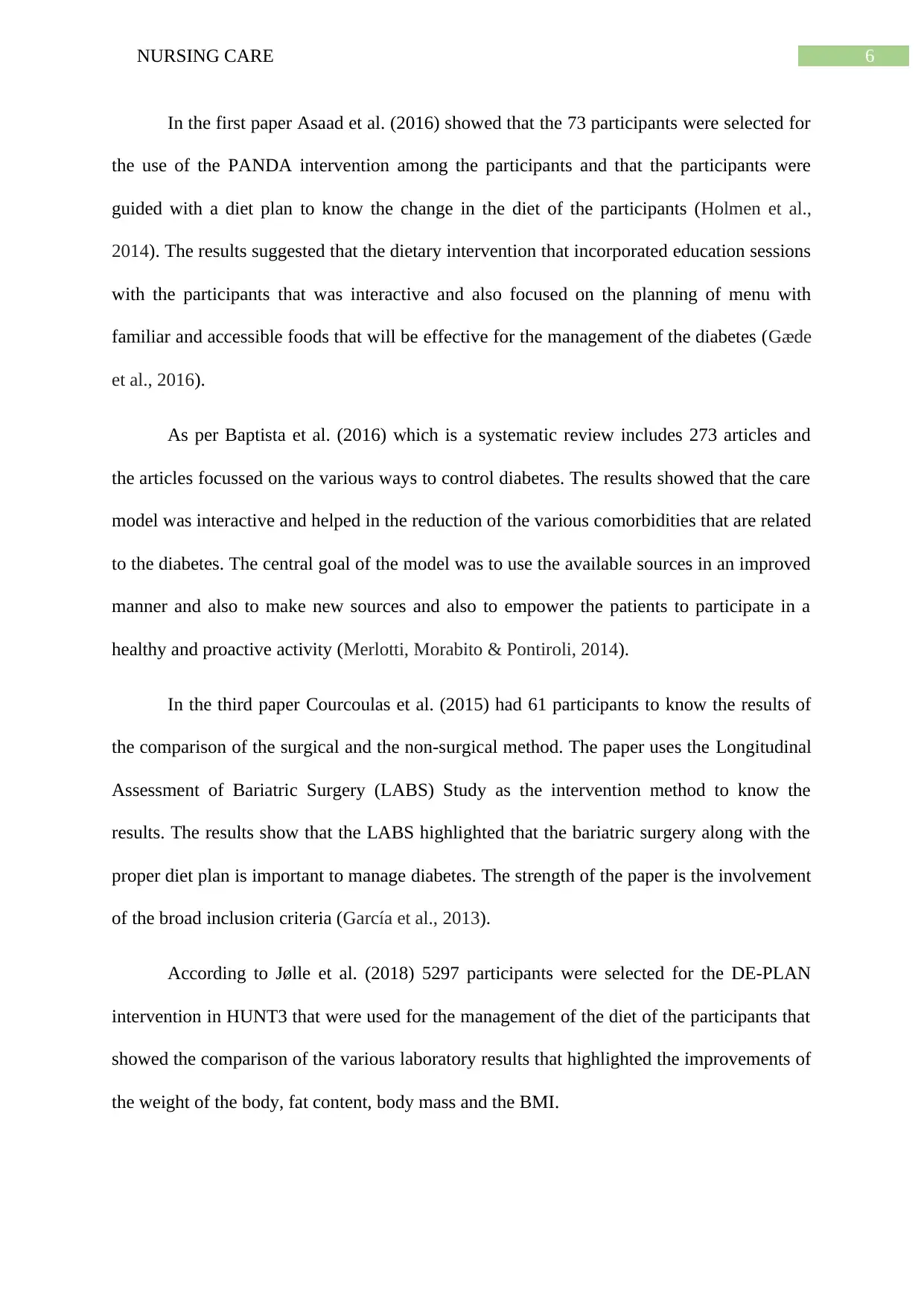
6NURSING CARE
In the first paper Asaad et al. (2016) showed that the 73 participants were selected for
the use of the PANDA intervention among the participants and that the participants were
guided with a diet plan to know the change in the diet of the participants (Holmen et al.,
2014). The results suggested that the dietary intervention that incorporated education sessions
with the participants that was interactive and also focused on the planning of menu with
familiar and accessible foods that will be effective for the management of the diabetes (Gæde
et al., 2016).
As per Baptista et al. (2016) which is a systematic review includes 273 articles and
the articles focussed on the various ways to control diabetes. The results showed that the care
model was interactive and helped in the reduction of the various comorbidities that are related
to the diabetes. The central goal of the model was to use the available sources in an improved
manner and also to make new sources and also to empower the patients to participate in a
healthy and proactive activity (Merlotti, Morabito & Pontiroli, 2014).
In the third paper Courcoulas et al. (2015) had 61 participants to know the results of
the comparison of the surgical and the non-surgical method. The paper uses the Longitudinal
Assessment of Bariatric Surgery (LABS) Study as the intervention method to know the
results. The results show that the LABS highlighted that the bariatric surgery along with the
proper diet plan is important to manage diabetes. The strength of the paper is the involvement
of the broad inclusion criteria (García et al., 2013).
According to Jølle et al. (2018) 5297 participants were selected for the DE-PLAN
intervention in HUNT3 that were used for the management of the diet of the participants that
showed the comparison of the various laboratory results that highlighted the improvements of
the weight of the body, fat content, body mass and the BMI.
In the first paper Asaad et al. (2016) showed that the 73 participants were selected for
the use of the PANDA intervention among the participants and that the participants were
guided with a diet plan to know the change in the diet of the participants (Holmen et al.,
2014). The results suggested that the dietary intervention that incorporated education sessions
with the participants that was interactive and also focused on the planning of menu with
familiar and accessible foods that will be effective for the management of the diabetes (Gæde
et al., 2016).
As per Baptista et al. (2016) which is a systematic review includes 273 articles and
the articles focussed on the various ways to control diabetes. The results showed that the care
model was interactive and helped in the reduction of the various comorbidities that are related
to the diabetes. The central goal of the model was to use the available sources in an improved
manner and also to make new sources and also to empower the patients to participate in a
healthy and proactive activity (Merlotti, Morabito & Pontiroli, 2014).
In the third paper Courcoulas et al. (2015) had 61 participants to know the results of
the comparison of the surgical and the non-surgical method. The paper uses the Longitudinal
Assessment of Bariatric Surgery (LABS) Study as the intervention method to know the
results. The results show that the LABS highlighted that the bariatric surgery along with the
proper diet plan is important to manage diabetes. The strength of the paper is the involvement
of the broad inclusion criteria (García et al., 2013).
According to Jølle et al. (2018) 5297 participants were selected for the DE-PLAN
intervention in HUNT3 that were used for the management of the diet of the participants that
showed the comparison of the various laboratory results that highlighted the improvements of
the weight of the body, fat content, body mass and the BMI.
Paraphrase This Document
Need a fresh take? Get an instant paraphrase of this document with our AI Paraphraser
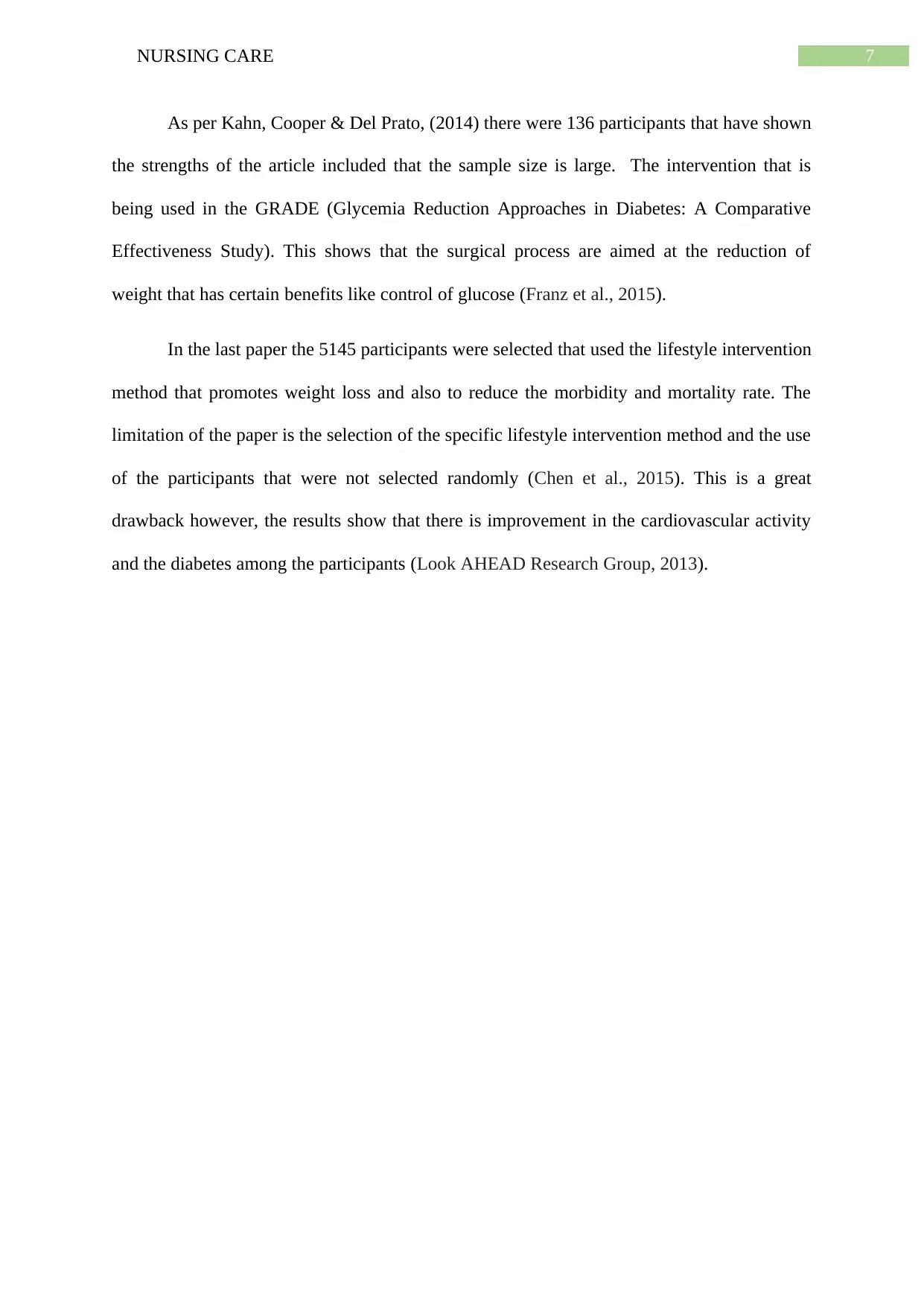
7NURSING CARE
As per Kahn, Cooper & Del Prato, (2014) there were 136 participants that have shown
the strengths of the article included that the sample size is large. The intervention that is
being used in the GRADE (Glycemia Reduction Approaches in Diabetes: A Comparative
Effectiveness Study). This shows that the surgical process are aimed at the reduction of
weight that has certain benefits like control of glucose (Franz et al., 2015).
In the last paper the 5145 participants were selected that used the lifestyle intervention
method that promotes weight loss and also to reduce the morbidity and mortality rate. The
limitation of the paper is the selection of the specific lifestyle intervention method and the use
of the participants that were not selected randomly (Chen et al., 2015). This is a great
drawback however, the results show that there is improvement in the cardiovascular activity
and the diabetes among the participants (Look AHEAD Research Group, 2013).
As per Kahn, Cooper & Del Prato, (2014) there were 136 participants that have shown
the strengths of the article included that the sample size is large. The intervention that is
being used in the GRADE (Glycemia Reduction Approaches in Diabetes: A Comparative
Effectiveness Study). This shows that the surgical process are aimed at the reduction of
weight that has certain benefits like control of glucose (Franz et al., 2015).
In the last paper the 5145 participants were selected that used the lifestyle intervention
method that promotes weight loss and also to reduce the morbidity and mortality rate. The
limitation of the paper is the selection of the specific lifestyle intervention method and the use
of the participants that were not selected randomly (Chen et al., 2015). This is a great
drawback however, the results show that there is improvement in the cardiovascular activity
and the diabetes among the participants (Look AHEAD Research Group, 2013).
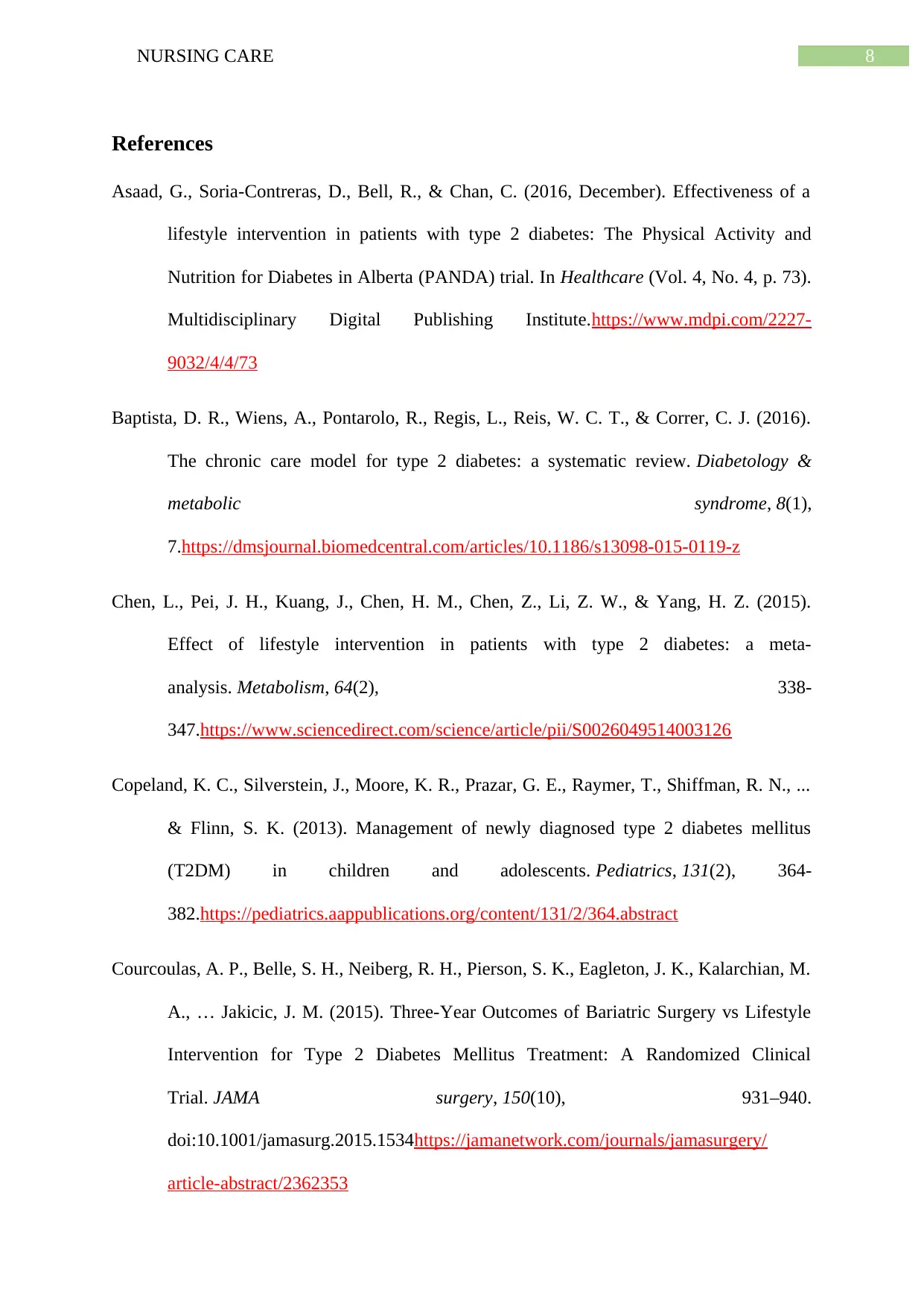
8NURSING CARE
References
Asaad, G., Soria-Contreras, D., Bell, R., & Chan, C. (2016, December). Effectiveness of a
lifestyle intervention in patients with type 2 diabetes: The Physical Activity and
Nutrition for Diabetes in Alberta (PANDA) trial. In Healthcare (Vol. 4, No. 4, p. 73).
Multidisciplinary Digital Publishing Institute.https://www.mdpi.com/2227-
9032/4/4/73
Baptista, D. R., Wiens, A., Pontarolo, R., Regis, L., Reis, W. C. T., & Correr, C. J. (2016).
The chronic care model for type 2 diabetes: a systematic review. Diabetology &
metabolic syndrome, 8(1),
7.https://dmsjournal.biomedcentral.com/articles/10.1186/s13098-015-0119-z
Chen, L., Pei, J. H., Kuang, J., Chen, H. M., Chen, Z., Li, Z. W., & Yang, H. Z. (2015).
Effect of lifestyle intervention in patients with type 2 diabetes: a meta-
analysis. Metabolism, 64(2), 338-
347.https://www.sciencedirect.com/science/article/pii/S0026049514003126
Copeland, K. C., Silverstein, J., Moore, K. R., Prazar, G. E., Raymer, T., Shiffman, R. N., ...
& Flinn, S. K. (2013). Management of newly diagnosed type 2 diabetes mellitus
(T2DM) in children and adolescents. Pediatrics, 131(2), 364-
382.https://pediatrics.aappublications.org/content/131/2/364.abstract
Courcoulas, A. P., Belle, S. H., Neiberg, R. H., Pierson, S. K., Eagleton, J. K., Kalarchian, M.
A., … Jakicic, J. M. (2015). Three-Year Outcomes of Bariatric Surgery vs Lifestyle
Intervention for Type 2 Diabetes Mellitus Treatment: A Randomized Clinical
Trial. JAMA surgery, 150(10), 931–940.
doi:10.1001/jamasurg.2015.1534https://jamanetwork.com/journals/jamasurgery/
article-abstract/2362353
References
Asaad, G., Soria-Contreras, D., Bell, R., & Chan, C. (2016, December). Effectiveness of a
lifestyle intervention in patients with type 2 diabetes: The Physical Activity and
Nutrition for Diabetes in Alberta (PANDA) trial. In Healthcare (Vol. 4, No. 4, p. 73).
Multidisciplinary Digital Publishing Institute.https://www.mdpi.com/2227-
9032/4/4/73
Baptista, D. R., Wiens, A., Pontarolo, R., Regis, L., Reis, W. C. T., & Correr, C. J. (2016).
The chronic care model for type 2 diabetes: a systematic review. Diabetology &
metabolic syndrome, 8(1),
7.https://dmsjournal.biomedcentral.com/articles/10.1186/s13098-015-0119-z
Chen, L., Pei, J. H., Kuang, J., Chen, H. M., Chen, Z., Li, Z. W., & Yang, H. Z. (2015).
Effect of lifestyle intervention in patients with type 2 diabetes: a meta-
analysis. Metabolism, 64(2), 338-
347.https://www.sciencedirect.com/science/article/pii/S0026049514003126
Copeland, K. C., Silverstein, J., Moore, K. R., Prazar, G. E., Raymer, T., Shiffman, R. N., ...
& Flinn, S. K. (2013). Management of newly diagnosed type 2 diabetes mellitus
(T2DM) in children and adolescents. Pediatrics, 131(2), 364-
382.https://pediatrics.aappublications.org/content/131/2/364.abstract
Courcoulas, A. P., Belle, S. H., Neiberg, R. H., Pierson, S. K., Eagleton, J. K., Kalarchian, M.
A., … Jakicic, J. M. (2015). Three-Year Outcomes of Bariatric Surgery vs Lifestyle
Intervention for Type 2 Diabetes Mellitus Treatment: A Randomized Clinical
Trial. JAMA surgery, 150(10), 931–940.
doi:10.1001/jamasurg.2015.1534https://jamanetwork.com/journals/jamasurgery/
article-abstract/2362353
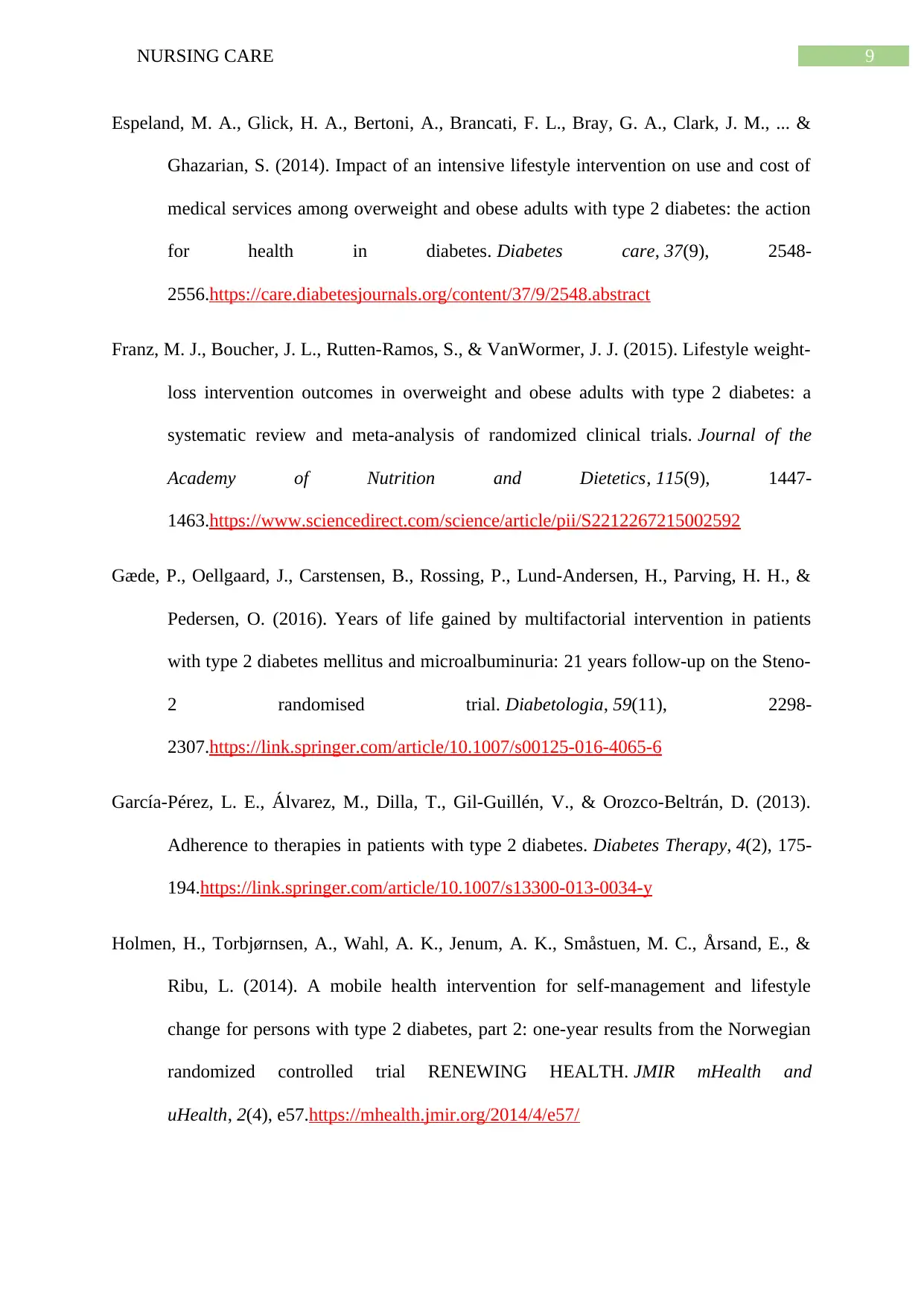
9NURSING CARE
Espeland, M. A., Glick, H. A., Bertoni, A., Brancati, F. L., Bray, G. A., Clark, J. M., ... &
Ghazarian, S. (2014). Impact of an intensive lifestyle intervention on use and cost of
medical services among overweight and obese adults with type 2 diabetes: the action
for health in diabetes. Diabetes care, 37(9), 2548-
2556.https://care.diabetesjournals.org/content/37/9/2548.abstract
Franz, M. J., Boucher, J. L., Rutten-Ramos, S., & VanWormer, J. J. (2015). Lifestyle weight-
loss intervention outcomes in overweight and obese adults with type 2 diabetes: a
systematic review and meta-analysis of randomized clinical trials. Journal of the
Academy of Nutrition and Dietetics, 115(9), 1447-
1463.https://www.sciencedirect.com/science/article/pii/S2212267215002592
Gæde, P., Oellgaard, J., Carstensen, B., Rossing, P., Lund-Andersen, H., Parving, H. H., &
Pedersen, O. (2016). Years of life gained by multifactorial intervention in patients
with type 2 diabetes mellitus and microalbuminuria: 21 years follow-up on the Steno-
2 randomised trial. Diabetologia, 59(11), 2298-
2307.https://link.springer.com/article/10.1007/s00125-016-4065-6
García-Pérez, L. E., Álvarez, M., Dilla, T., Gil-Guillén, V., & Orozco-Beltrán, D. (2013).
Adherence to therapies in patients with type 2 diabetes. Diabetes Therapy, 4(2), 175-
194.https://link.springer.com/article/10.1007/s13300-013-0034-y
Holmen, H., Torbjørnsen, A., Wahl, A. K., Jenum, A. K., Småstuen, M. C., Årsand, E., &
Ribu, L. (2014). A mobile health intervention for self-management and lifestyle
change for persons with type 2 diabetes, part 2: one-year results from the Norwegian
randomized controlled trial RENEWING HEALTH. JMIR mHealth and
uHealth, 2(4), e57.https://mhealth.jmir.org/2014/4/e57/
Espeland, M. A., Glick, H. A., Bertoni, A., Brancati, F. L., Bray, G. A., Clark, J. M., ... &
Ghazarian, S. (2014). Impact of an intensive lifestyle intervention on use and cost of
medical services among overweight and obese adults with type 2 diabetes: the action
for health in diabetes. Diabetes care, 37(9), 2548-
2556.https://care.diabetesjournals.org/content/37/9/2548.abstract
Franz, M. J., Boucher, J. L., Rutten-Ramos, S., & VanWormer, J. J. (2015). Lifestyle weight-
loss intervention outcomes in overweight and obese adults with type 2 diabetes: a
systematic review and meta-analysis of randomized clinical trials. Journal of the
Academy of Nutrition and Dietetics, 115(9), 1447-
1463.https://www.sciencedirect.com/science/article/pii/S2212267215002592
Gæde, P., Oellgaard, J., Carstensen, B., Rossing, P., Lund-Andersen, H., Parving, H. H., &
Pedersen, O. (2016). Years of life gained by multifactorial intervention in patients
with type 2 diabetes mellitus and microalbuminuria: 21 years follow-up on the Steno-
2 randomised trial. Diabetologia, 59(11), 2298-
2307.https://link.springer.com/article/10.1007/s00125-016-4065-6
García-Pérez, L. E., Álvarez, M., Dilla, T., Gil-Guillén, V., & Orozco-Beltrán, D. (2013).
Adherence to therapies in patients with type 2 diabetes. Diabetes Therapy, 4(2), 175-
194.https://link.springer.com/article/10.1007/s13300-013-0034-y
Holmen, H., Torbjørnsen, A., Wahl, A. K., Jenum, A. K., Småstuen, M. C., Årsand, E., &
Ribu, L. (2014). A mobile health intervention for self-management and lifestyle
change for persons with type 2 diabetes, part 2: one-year results from the Norwegian
randomized controlled trial RENEWING HEALTH. JMIR mHealth and
uHealth, 2(4), e57.https://mhealth.jmir.org/2014/4/e57/
Secure Best Marks with AI Grader
Need help grading? Try our AI Grader for instant feedback on your assignments.
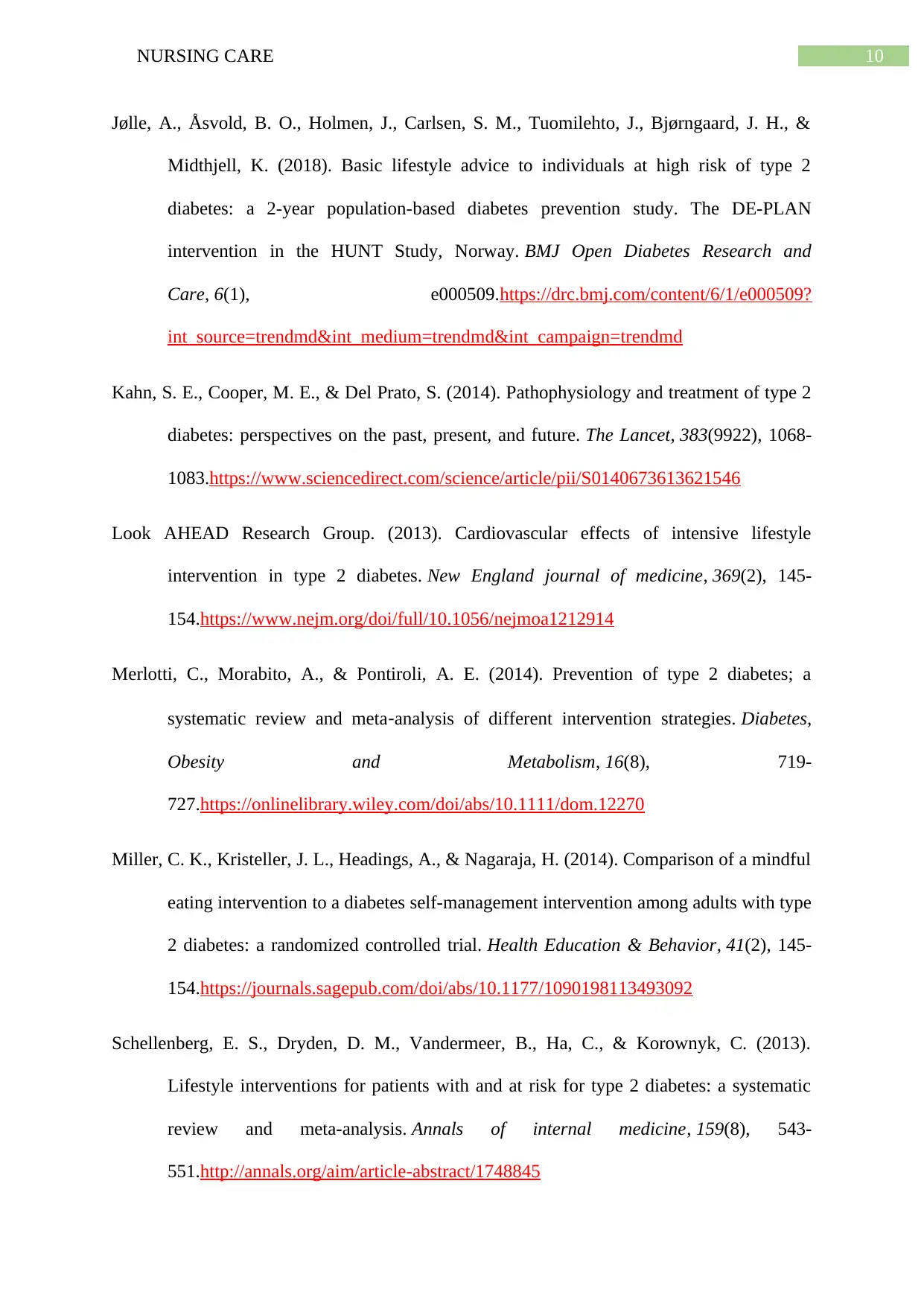
10NURSING CARE
Jølle, A., Åsvold, B. O., Holmen, J., Carlsen, S. M., Tuomilehto, J., Bjørngaard, J. H., &
Midthjell, K. (2018). Basic lifestyle advice to individuals at high risk of type 2
diabetes: a 2-year population-based diabetes prevention study. The DE-PLAN
intervention in the HUNT Study, Norway. BMJ Open Diabetes Research and
Care, 6(1), e000509.https://drc.bmj.com/content/6/1/e000509?
int_source=trendmd&int_medium=trendmd&int_campaign=trendmd
Kahn, S. E., Cooper, M. E., & Del Prato, S. (2014). Pathophysiology and treatment of type 2
diabetes: perspectives on the past, present, and future. The Lancet, 383(9922), 1068-
1083.https://www.sciencedirect.com/science/article/pii/S0140673613621546
Look AHEAD Research Group. (2013). Cardiovascular effects of intensive lifestyle
intervention in type 2 diabetes. New England journal of medicine, 369(2), 145-
154.https://www.nejm.org/doi/full/10.1056/nejmoa1212914
Merlotti, C., Morabito, A., & Pontiroli, A. E. (2014). Prevention of type 2 diabetes; a
systematic review and meta‐analysis of different intervention strategies. Diabetes,
Obesity and Metabolism, 16(8), 719-
727.https://onlinelibrary.wiley.com/doi/abs/10.1111/dom.12270
Miller, C. K., Kristeller, J. L., Headings, A., & Nagaraja, H. (2014). Comparison of a mindful
eating intervention to a diabetes self-management intervention among adults with type
2 diabetes: a randomized controlled trial. Health Education & Behavior, 41(2), 145-
154.https://journals.sagepub.com/doi/abs/10.1177/1090198113493092
Schellenberg, E. S., Dryden, D. M., Vandermeer, B., Ha, C., & Korownyk, C. (2013).
Lifestyle interventions for patients with and at risk for type 2 diabetes: a systematic
review and meta-analysis. Annals of internal medicine, 159(8), 543-
551.http://annals.org/aim/article-abstract/1748845
Jølle, A., Åsvold, B. O., Holmen, J., Carlsen, S. M., Tuomilehto, J., Bjørngaard, J. H., &
Midthjell, K. (2018). Basic lifestyle advice to individuals at high risk of type 2
diabetes: a 2-year population-based diabetes prevention study. The DE-PLAN
intervention in the HUNT Study, Norway. BMJ Open Diabetes Research and
Care, 6(1), e000509.https://drc.bmj.com/content/6/1/e000509?
int_source=trendmd&int_medium=trendmd&int_campaign=trendmd
Kahn, S. E., Cooper, M. E., & Del Prato, S. (2014). Pathophysiology and treatment of type 2
diabetes: perspectives on the past, present, and future. The Lancet, 383(9922), 1068-
1083.https://www.sciencedirect.com/science/article/pii/S0140673613621546
Look AHEAD Research Group. (2013). Cardiovascular effects of intensive lifestyle
intervention in type 2 diabetes. New England journal of medicine, 369(2), 145-
154.https://www.nejm.org/doi/full/10.1056/nejmoa1212914
Merlotti, C., Morabito, A., & Pontiroli, A. E. (2014). Prevention of type 2 diabetes; a
systematic review and meta‐analysis of different intervention strategies. Diabetes,
Obesity and Metabolism, 16(8), 719-
727.https://onlinelibrary.wiley.com/doi/abs/10.1111/dom.12270
Miller, C. K., Kristeller, J. L., Headings, A., & Nagaraja, H. (2014). Comparison of a mindful
eating intervention to a diabetes self-management intervention among adults with type
2 diabetes: a randomized controlled trial. Health Education & Behavior, 41(2), 145-
154.https://journals.sagepub.com/doi/abs/10.1177/1090198113493092
Schellenberg, E. S., Dryden, D. M., Vandermeer, B., Ha, C., & Korownyk, C. (2013).
Lifestyle interventions for patients with and at risk for type 2 diabetes: a systematic
review and meta-analysis. Annals of internal medicine, 159(8), 543-
551.http://annals.org/aim/article-abstract/1748845
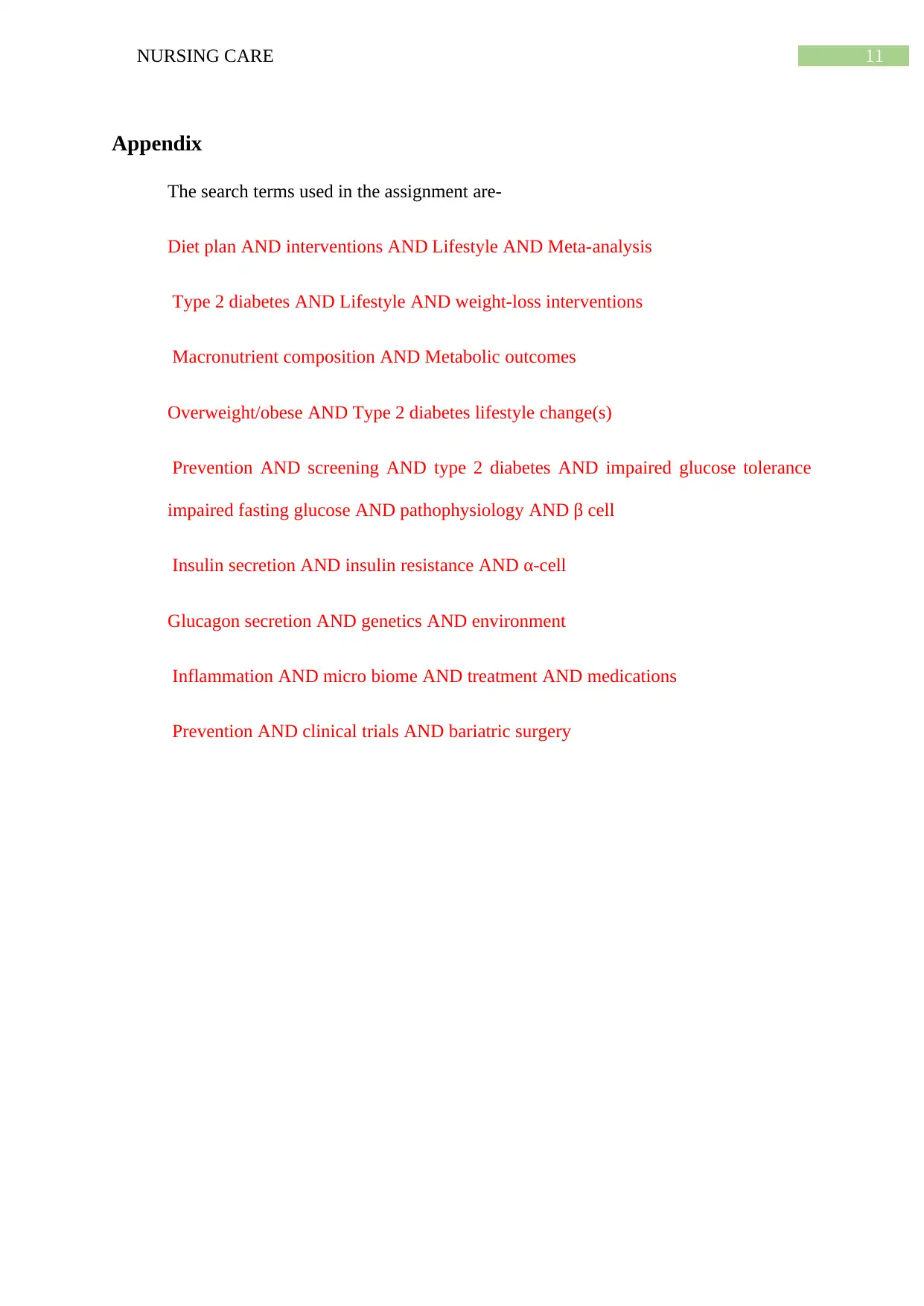
11NURSING CARE
Appendix
The search terms used in the assignment are-
Diet plan AND interventions AND Lifestyle AND Meta-analysis
Type 2 diabetes AND Lifestyle AND weight-loss interventions
Macronutrient composition AND Metabolic outcomes
Overweight/obese AND Type 2 diabetes lifestyle change(s)
Prevention AND screening AND type 2 diabetes AND impaired glucose tolerance
impaired fasting glucose AND pathophysiology AND β cell
Insulin secretion AND insulin resistance AND α-cell
Glucagon secretion AND genetics AND environment
Inflammation AND micro biome AND treatment AND medications
Prevention AND clinical trials AND bariatric surgery
Appendix
The search terms used in the assignment are-
Diet plan AND interventions AND Lifestyle AND Meta-analysis
Type 2 diabetes AND Lifestyle AND weight-loss interventions
Macronutrient composition AND Metabolic outcomes
Overweight/obese AND Type 2 diabetes lifestyle change(s)
Prevention AND screening AND type 2 diabetes AND impaired glucose tolerance
impaired fasting glucose AND pathophysiology AND β cell
Insulin secretion AND insulin resistance AND α-cell
Glucagon secretion AND genetics AND environment
Inflammation AND micro biome AND treatment AND medications
Prevention AND clinical trials AND bariatric surgery
1 out of 12
Related Documents
Your All-in-One AI-Powered Toolkit for Academic Success.
+13062052269
info@desklib.com
Available 24*7 on WhatsApp / Email
![[object Object]](/_next/static/media/star-bottom.7253800d.svg)
Unlock your academic potential
© 2024 | Zucol Services PVT LTD | All rights reserved.





